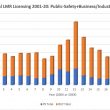Will narrowbanding rules impact LTE deployment?
As public-safety officials prepare to begin a full-court press on Capitol Hill for legislation that would make the 700 MHz D Block spectrum and funding available for first-responder mobile broadband networks nationwide, an official for one LTE manufacturer contends that an anticipated FCC decision regarding narrowband technology could make a big difference in the deployment of broadband for public safety.
One of the more significant debates in the public-safety communications sector is when LTE networks can support mission-critical voice that provides the reliability and features — most notably, one-to-many and peer-to-peer communications — that public safety expects. Some have argued that it may only be a few years away, while others contend that it won’t happen for at least a decade. Some believe it could take multiple decades.
While there is a wide range of estimates, most industry observers acknowledge that there are two primary components to making mission-critical voice a reality. First, technical hurdles that must be cleared — remember, commercial voice isn’t even part of the LTE standard being deployed today, although it will in future version of the technology. Second, the technical solutions need to be incorporated into the LTE standard.
Morgan Wright, vice president of Alcatel-Lucent’s global public-safety segment, said both components can be addressed in a relatively short timeframe, if manufacturers believe there is an adequate market demand.
“Any of it can be done,” Wright said. “The question is whether it’s worth [manufacturers’] time.
“If there’s nothing economically rewarding to do it, why does anybody want to do it? Sorry, but people aren’t out there building just for the public good. You put a lot of people out of business if we generate zero revenue for the things we’re developing.”
One potentially important driving force to creating a significant market for mission-critical LTE voice will be the FCC’s position on its requirement to have public-safety agencies with UHF and VHF radio systems move from 25 kHz channels to 12.5 kHz channels by Jan. 1, 2013.
For many entities, this narrowbanding process — an unfunded government mandate — promises to be extremely expensive, with the New York City expecting the massive project to cost it several hundred million dollars. Not only could this drain capital funds, but such an investment effectively obligates narrowbanded agencies to maintain their LMR networks for at least another 10 to 15 years, Wright said.
With this in mind, Wright said he believes FCC officials should consider providing narrowbanding entities with the flexibility of either narrowbanding or making a commitment to LTE mission-critical voice. The latter option would require the public-safety agency to make reported progress toward broadband voice in a given time period — think five years — thereby creating the market demand manufacturers need to drive the technical-development and standards-approval processes, he said.
Meanwhile, the agencies would maintain their current LMR networks.
“If you don’t, this will be relegated to a data-only network for a very long time to come,” Wright said.
It’s an interesting argument, one that New York City officials have been making for more than a year. Certainly, it would be easier for local, state and federal officials to justify spending money on LTE networks that can provide both voice and data for public safety, instead of just voice.
But there could be considerable risk involved, because the absence of a technical solution in the near future could leave some agencies with aging voice systems that would not be interoperable with narrowbanded neighbors. In addition, public-safety agencies typically have been understandably hesitant to have “bleeding-edge” technologies in mission-critical functions. Greater clarity this year on the prospects of mission-critical LTE voice likely will be sought by both public safety and the FCC before a final decision can be made.
What do you think? Tell us in the comment box below.

















